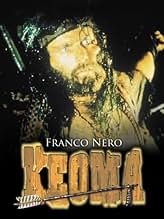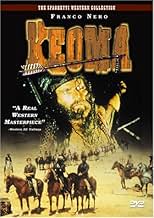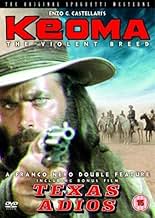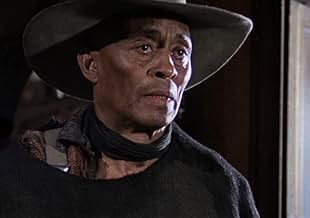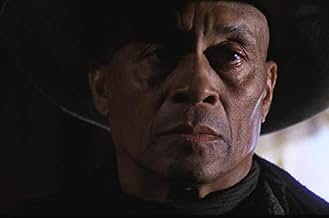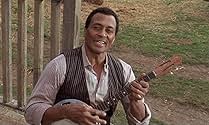PUNTUACIÓN EN IMDb
7,0/10
6,6 mil
TU PUNTUACIÓN
Un ex pistolero de la Unión intenta proteger su ciudad natal de ser anulada por sus medios hermanos racistas y un tirano confederado.Un ex pistolero de la Unión intenta proteger su ciudad natal de ser anulada por sus medios hermanos racistas y un tirano confederado.Un ex pistolero de la Unión intenta proteger su ciudad natal de ser anulada por sus medios hermanos racistas y un tirano confederado.
- Dirección
- Guión
- Reparto principal
Joshua Sinclair
- Sam Shannon
- (as John Loffredo)
Donald O'Brien
- Caldwell
- (as Donald O'Brian)
Leonardo Scavino
- Doctor
- (as Leon Lenoir)
Antonio Basile
- Caldwell's Henchman
- (sin acreditar)
Giovanni Bonadonna
- Caldwell's Henchman
- (sin acreditar)
Armando Bottin
- Caldwell's Henchman
- (sin acreditar)
Aldo Canti
- Wagon Fugitive
- (sin acreditar)
- …
Felice Ceciarelli
- Caldwell's Henchman
- (sin acreditar)
Reseñas destacadas
Though to be clear I wouldn't go as far as to call it "the best". Something the people involved are quick to point out or to. This is really good and you have a very charismatic (and hairy chested) Franco Nero starring. You also have supernatural elements, that may not be fully explained (not even by all the extras on the disc).
And you have old school shooutous, where bad guys seem to only need one bullet to bite the dust (literally), whereas good people have to be shot quite a few times mostly. So yes there are things that may seem or feel dated, but the overall sense is quite great. Not to mention the performances. Really telling and really inspired overall.
And you have old school shooutous, where bad guys seem to only need one bullet to bite the dust (literally), whereas good people have to be shot quite a few times mostly. So yes there are things that may seem or feel dated, but the overall sense is quite great. Not to mention the performances. Really telling and really inspired overall.
This film has so much that works so well, it's a shame one thing keeps it from working entirely l: the music. The single most annoying song I've ever heard in a film. Secondly the newest "restored" version inexplicably has two totally different English voices dubbed for Nero. His first few lines are delivered in a deep clear "radio announcer" pure English baritone, the rest of the film is in a poorly faked accent. What exactly would be the reason for this? Other than those two distractions, a great late era entry to the genre.
Talk to most Spaghetti Western fans and they will declare Keoma to be one of the finest of the genre's movies, and probably the best of the latter day ones. However they will also most probably comment on the atrocious soundtrack, which does take some getting used to. I honestly believe that if this movie had been given the Morricone touch, it would be firmly cemented as a true Spaghetti classic, standing side by side with The Big Gundown, Face to Face and Bullet for the General.
Aside from Django, this is Franco Nero's best role. A half breed venger, riding into a town decimated by both the plague and a gang of racist ex-Confederates, which includes his three hateful "brothers" in their ranks. There are also fine turns by William Berger as Keoma's adopted father Shannon, and Woody Strode as Keoma's childhood hero turned drunk, George.
As always, Castellari has injected true class into this film, with slow motion shootouts, effective flashbacks and clever camera tricks. This film is a true fitting end to the Spaghetti hay day, which had begun to loose its charm due to the ever increasing stupidity of the comedy westerns. The only negative aspect is that wretched soundtrack. Oh where was Morricone when we really needed him?
Aside from Django, this is Franco Nero's best role. A half breed venger, riding into a town decimated by both the plague and a gang of racist ex-Confederates, which includes his three hateful "brothers" in their ranks. There are also fine turns by William Berger as Keoma's adopted father Shannon, and Woody Strode as Keoma's childhood hero turned drunk, George.
As always, Castellari has injected true class into this film, with slow motion shootouts, effective flashbacks and clever camera tricks. This film is a true fitting end to the Spaghetti hay day, which had begun to loose its charm due to the ever increasing stupidity of the comedy westerns. The only negative aspect is that wretched soundtrack. Oh where was Morricone when we really needed him?
A mestizo ex-soldier named Keoma (Franco Nero's long hair is a wig) helps a pregnant woman (Olga Karlatos) from cutthroats. Keoma (the word/name Keoma means freedom) returns to a small town after the Civil War . The ghastly village is ruled by violent outlaw gangs (led by Donald O'Brien), along with Keoma's three brother . Half-breed Keoma is helped by an alcoholic old man (Woody Strode) and his adoptive father (William Berger). The bandits leader prohibits the inhabitants leave from damned little town besieged by pest .
This twilight spaghetti Western packs a decrepit aesthetic, racist denounce and innovating scenarios set in Elios studios by designer production Carlo Simi, Sergio Leone's regular. There is full of action in the movie, guaranteeing fist-play, stunts and shootouts every few minutes and in Sam Peckinpah style. Franco Nero is cool, he bears a remarkable physical resemblance to JesusChrist , he helps a hapless pregnant and is crucified in Christian symbolic sequence. Interesting and thought-provoking screenplay by Luigi Montefiori or George Eastman who starred numerous Westerns. The plot of the film was mostly improvised at the same time the film was made, but director Enzo G. Castellari didn't appeal the original story. Because of problems with Schedule, the script was written for next day every evening, after filming at the day. Usual Spaghetti western secondaries appear, such as: William Berger, Ken Wood, Robert Dell'Acqua and Ricardo Pizzuti of the Terence Hil and Spencer films. Sensitive, perceptible musical score by Guido and Maurizio De Angelis with emotive atmosphere nearly the songs performed by Bob Dylan and Leonard Cohen. The picture was well produced by Manolo Bolognini, usual producer of Italian Westerns, such as: ¨Django¨, ¨Goodbye Texas¨ , ¨Boot Hill¨ , ¨Gunman of Ave Maria¨ and ¨California¨. Director Enzo G. Castellari has stated that out of all the films he has directed, Keoma this is his personal favorite . Followed by a sequel titled 'Jonathan of the bears' (1994) again with Franco Nero and director Enzo G. Castellari, being shot in Russia and including notable reminiscences with 'Dances with wolves', but the film failed at box office . Keoma was the 'swang song 'of Spaghetti because made not much after and resulted to be the 'coup of grace' of Italian Western.
This twilight spaghetti Western packs a decrepit aesthetic, racist denounce and innovating scenarios set in Elios studios by designer production Carlo Simi, Sergio Leone's regular. There is full of action in the movie, guaranteeing fist-play, stunts and shootouts every few minutes and in Sam Peckinpah style. Franco Nero is cool, he bears a remarkable physical resemblance to JesusChrist , he helps a hapless pregnant and is crucified in Christian symbolic sequence. Interesting and thought-provoking screenplay by Luigi Montefiori or George Eastman who starred numerous Westerns. The plot of the film was mostly improvised at the same time the film was made, but director Enzo G. Castellari didn't appeal the original story. Because of problems with Schedule, the script was written for next day every evening, after filming at the day. Usual Spaghetti western secondaries appear, such as: William Berger, Ken Wood, Robert Dell'Acqua and Ricardo Pizzuti of the Terence Hil and Spencer films. Sensitive, perceptible musical score by Guido and Maurizio De Angelis with emotive atmosphere nearly the songs performed by Bob Dylan and Leonard Cohen. The picture was well produced by Manolo Bolognini, usual producer of Italian Westerns, such as: ¨Django¨, ¨Goodbye Texas¨ , ¨Boot Hill¨ , ¨Gunman of Ave Maria¨ and ¨California¨. Director Enzo G. Castellari has stated that out of all the films he has directed, Keoma this is his personal favorite . Followed by a sequel titled 'Jonathan of the bears' (1994) again with Franco Nero and director Enzo G. Castellari, being shot in Russia and including notable reminiscences with 'Dances with wolves', but the film failed at box office . Keoma was the 'swang song 'of Spaghetti because made not much after and resulted to be the 'coup of grace' of Italian Western.
Review of English-language Blue Underground version:
My, my these Spaghettis. In Keoma (Franco Nero), we have a man who has descended into hell, he has become an annihilator. The landscape is infernal, from the Breughelesque sets to the leering henchman to the blasted mountains. For his enemies, he has two barrels of a shotgun, and no pity. The hell is as much in his mind as it is in the town he rides into. He is a man with no place, ideology or purpose. Unlike Eastwood's characters in the dollars trilogy who are without history or neuroses, with Nero as Keoma we have a profound psychological portrait of a man in spiritual agony, on the road to obliteration and self-immolation.
The scenario is also hellish, we have a town and a region that has been taken over by a warlord. He and his henchman block access from and to the outside world. The townsfolk are all infected with a plague, and rather than given access to medical aid, they are put in a concentration camp and forced to mine for silver, or simply murdered. The town is left to the henchmen and their trollops. This for me is very unlike a western in the traditional American sense. In the American western, there are always the upright people of the town to appeal to, there is a sheriff, or as a last resort the cavalry. People may be run off their land or be claim-jumped, but they are never forced into slave labour.
What we have in Keoma, and in similar movies such as Django and Django Strikes Again, is a fundamentally African western, which is probably why Spaghetti goes down so well on that continent. The town in Keoma is more reminiscent of somewhere in Sierra Leone than the Sierra Nevada. There is total brutal oppression of the populace. There is a reckless attitude towards the value of life. Keoma is likewise a more fitting hero for such a landscape, he is almost a Christ-like figure in the sense that he is betrayed or deserted by everyone in this movie, his family, the oppressed, and the liberated. When Keoma is crucified on a wagonwheel the artisans, politicos, henchmen and whores celebrate a change of leadership in the saloon that was entirely down to him. He is constantly grimy, his hair is totally overgrown, he is hirsute, sweaty, and wears no overshirt. Seeing him shove his pistol down the back of his trousers against his bare back will make the ladies a little queasy.
This movie has a very dreamlike atmosphere. The reason for this is that there is no real cohesive plot. Apparently Castellari threw the script in the bin immediately prior to shooting and adopted a completely improvisational approach. The only consistency to the movie is that of image and emotion. Throughout the movie is laced with the anguish of haunted souls, and punctuated by the slow-mo killings after the fashion of Peckinpah. The improvisation can unfortunately be quite clear. Some of the actors were writing their own lines the night before shooting. The dialogue is not always brilliant to say the least, and it is not helped by Nero's far from accent-less English. However this is about the only film where improvisation could work, simply because it is entirely beneficial to the oneiric, logic-less atmosphere.
The De Angelis brothers' soundtrack will be interesting to some because of the untrained voices. Nero sings quite a lot of it himself, and you will have to suspend disbelief and accept it, because although the man clearly has no singing talent, there is an authenticity to his singing that is refreshing.
I'm not sure what Woody Strode was doing in this picture, but flashbacks of him shooting his bow add to the trippiness. Keoma the movie is not quite as far-out as something by Jodorowsky, but it's on the way.
My, my these Spaghettis. In Keoma (Franco Nero), we have a man who has descended into hell, he has become an annihilator. The landscape is infernal, from the Breughelesque sets to the leering henchman to the blasted mountains. For his enemies, he has two barrels of a shotgun, and no pity. The hell is as much in his mind as it is in the town he rides into. He is a man with no place, ideology or purpose. Unlike Eastwood's characters in the dollars trilogy who are without history or neuroses, with Nero as Keoma we have a profound psychological portrait of a man in spiritual agony, on the road to obliteration and self-immolation.
The scenario is also hellish, we have a town and a region that has been taken over by a warlord. He and his henchman block access from and to the outside world. The townsfolk are all infected with a plague, and rather than given access to medical aid, they are put in a concentration camp and forced to mine for silver, or simply murdered. The town is left to the henchmen and their trollops. This for me is very unlike a western in the traditional American sense. In the American western, there are always the upright people of the town to appeal to, there is a sheriff, or as a last resort the cavalry. People may be run off their land or be claim-jumped, but they are never forced into slave labour.
What we have in Keoma, and in similar movies such as Django and Django Strikes Again, is a fundamentally African western, which is probably why Spaghetti goes down so well on that continent. The town in Keoma is more reminiscent of somewhere in Sierra Leone than the Sierra Nevada. There is total brutal oppression of the populace. There is a reckless attitude towards the value of life. Keoma is likewise a more fitting hero for such a landscape, he is almost a Christ-like figure in the sense that he is betrayed or deserted by everyone in this movie, his family, the oppressed, and the liberated. When Keoma is crucified on a wagonwheel the artisans, politicos, henchmen and whores celebrate a change of leadership in the saloon that was entirely down to him. He is constantly grimy, his hair is totally overgrown, he is hirsute, sweaty, and wears no overshirt. Seeing him shove his pistol down the back of his trousers against his bare back will make the ladies a little queasy.
This movie has a very dreamlike atmosphere. The reason for this is that there is no real cohesive plot. Apparently Castellari threw the script in the bin immediately prior to shooting and adopted a completely improvisational approach. The only consistency to the movie is that of image and emotion. Throughout the movie is laced with the anguish of haunted souls, and punctuated by the slow-mo killings after the fashion of Peckinpah. The improvisation can unfortunately be quite clear. Some of the actors were writing their own lines the night before shooting. The dialogue is not always brilliant to say the least, and it is not helped by Nero's far from accent-less English. However this is about the only film where improvisation could work, simply because it is entirely beneficial to the oneiric, logic-less atmosphere.
The De Angelis brothers' soundtrack will be interesting to some because of the untrained voices. Nero sings quite a lot of it himself, and you will have to suspend disbelief and accept it, because although the man clearly has no singing talent, there is an authenticity to his singing that is refreshing.
I'm not sure what Woody Strode was doing in this picture, but flashbacks of him shooting his bow add to the trippiness. Keoma the movie is not quite as far-out as something by Jodorowsky, but it's on the way.
¿Sabías que...?
- CuriosidadesThe story line of the film was mostly improvised at the same time as the film was made. The original story treatment was written by Luigi Montefiori (aka George Eastman) and turned into a script by Mino Roli and Nico Ducci, but director Enzo G. Castellari didn't like what had been written by the latter two. Because of problems with the schedule, Castellari and actor Joshua Sinclair wrote the script for the next day every evening after filming of the day. Castellari was also open to suggestions from the cast and crew - Franco Nero has confirmed that he wrote some of his own dialogue.
- PifiasAt 7:08 riders on horseback in pursuit of two men running on foot fire their pistols. Both men on foot react as if hit by the first shot.
- Versiones alternativasGerman version was cut for violence and pacing reasons by 8 minutes to secure a "not under 16" rating. Despite that, it still got put on the index list by the BPjM which means various sales and advertising restrictions. Fortunately in 2003, the movie was removed from the index list and the FSK granted the uncut version a "not under 16" rating.
- ConexionesFeatured in L'Oeil du cyclone: Westernissimo (1995)
- Banda sonoraKeoma
(uncredited)
Music by Guido De Angelis & Maurizio De Angelis
Lyrics by Susan Duncan Smith and Cesare De Natale
Performed by Sibyl Mostert and Cesare De Natale
Selecciones populares
Inicia sesión para calificar y añadir a tu lista para recibir recomendaciones personalizadas
- How long is Keoma?Con tecnología de Alexa
Detalles
Contribuir a esta página
Sugerir un cambio o añadir el contenido que falta

Principal laguna de datos
By what name was Keoma (1976) officially released in India in English?
Responde

